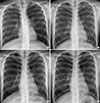Abstract
Diffuse panbronchiolitis (DPB) is a progressive inflammatory respiratory disease of unknown cause mainly occurring in East Asian people. Studies on causes of the disease point to a genetic predisposition unique to Asians, but the cause remains unknown. If untreated, DPB progresses to bronchiectasis, respiratory failure, and death. The age of patients at onset of the disease varies from young to elderly people with a peak at 40–60 years. A few cases of DPB have been reported in Korean adults since 1992; however, the case of DPB in children is uncommon. Herein, we describe a 16-year-old girl with DPB who presented with chronic cough and sputum.
Figures and Tables
References
1. Yamanaka A, Saiki S, Tamura S, Saito K. Problems in chronic obstructive bronchial diseases, with special reference to diffuse panbronchiolitis. Naika. 1969; 23:442–451.
3. Poletti V, Patelli M, Poletti G, Bertanti T, Spiga L. Diffuse panbronchiolitis observed in an Italian. Chest. 1990; 98:515–516.
5. Homma S, Sakamoto S, Kawabata M, Kishi K, Tsuboi E, Motoi N, et al. Comparative clinicopathology of obliterative bronchiolitis and diffuse panbronchiolitis. Respiration. 2006; 73:481–487.

6. Poletti V, Casoni G, Chilosi M, Zompatori M. Diffuse panbronchiolitis. Eur Respir J. 2006; 28:862–871.

7. Kim YW, Han SK, Shim YS, Kim KY, Han YC, Seo JW, et al. The first report of diffuse panbronchiolitis in Korea: five case reports. Intern Med. 1992; 31:695–701.

8. You JH, Lee HS, Lee KY, Hong JH, Lee MH, Lee BC. A case of diffuse panbronchiolitis developing in childhood. Korean J Pediatr. 2005; 48:97–100.
9. Hyatt RE, Scanlon PD, Nakamura M. Interpretation of pulmonary function tests: a practical guide. 3rd ed. Philadelphia: Lippincott: Williams & Wilkins;2009.
10. Hwang YI, Jung KS, Lim SY, Lee YS, Kwon NH. A validation study for the Korean version of chronic obstructive pulmonary disease assessment test (CAT). Tuberc Respir Dis (Seoul). 2013; 74:256–263.

11. Homma H, Yamanaka A, Tanimoto S, Tamura M, Chijimatsu Y, Kira S, et al. Diffuse panbronchiolitis: a disease of the transitional zone of the lung. Chest. 1983; 83:63–69.
12. Izumi T, Doi O, Nobechi A, Homma Y, Kino N, Nakata K, et al. Nation-wide survey of diffuse panbronchiolitis: annual report on the study of interstitial lung disease in 1982. Tokyo: Grant-in Aid from the Ministry of Health and Welfare of Japan;1983. p. 3–41.
13. Keicho N, Hijikata M. Genetic predisposition to diffuse panbronchiolitis. Respirology. 2011; 16:581–588.

14. Hijikata M, Matsushita I, Tanaka G, Tsuchiya T, Ito H, Tokunaga K, et al. Molecular cloning of two novel mucin-like genes in the disease-susceptibility locus for diffuse panbronchiolitis. Hum Genet. 2011; 129:117–128.

15. Jang MA, Kim SY, Jeong BH, Park HY, Jeon K, Kim JW, et al. Association of CFTR gene variants with nontuberculous mycobacterial lung disease in a Korean population with a low prevalence of cystic fibrosis. J Hum Genet. 2013; 58:298–303.

16. Nakata K. Revision of clinical guidelines for diffuse panbronchiolitis: annual report on the study of diffuse lung disease in 1998. Tokyo: Grant-in Aid from the Ministry of Health and Welfare of Japan;1999. p. 109–111.
17. Akira M, Kitatani F, Lee YS, Kita N, Yamamoto S, Higashihara T, et al. Diffuse panbronchiolitis: evaluation with high-resolution CT. Radiology. 1988; 168:433–438.

18. Kudoh S, Uetake T, Hagiwara K, Hirayama M, Hus LH, Kimura H, et al. Clinical effects of low-dose long-term erythromycin chemotherapy on diffuse panbronchiolitis. Nihon Kyobu Shikkan Gakkai Zasshi. 1987; 25:632–642.




 PDF
PDF ePub
ePub Citation
Citation Print
Print





 XML Download
XML Download